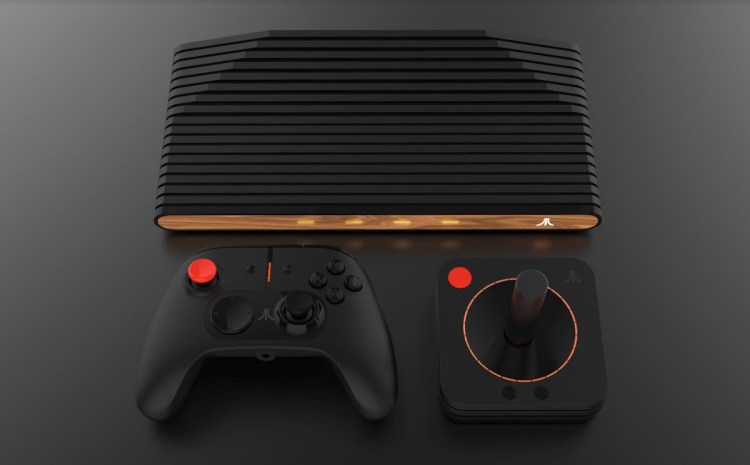Atari made a lot of noise last year when it announced its Ataribox game console. But in December, just as it was about to launch its crowdfunding campaign and preorders for the box, it hit the pause button. The company postponed its preorders, and its project general manager Feargal Mac Conuladh left.
Last week, during the Game Developers Conference, the company announced it was back on track and renamed the box the Atari VCS. I caught up with Atari CEO, Fred Chesnais, and we talked about the new plan to bring a retro-modern game console to Atari fans.
Chesnais showed off the latest prototype for the Linux-based machine with an Advanced Micro Devices processor, as well as its joystick and game controller designs. The new name evokes nostalgia for Atari’s halcyon years.
Here’s an edited transcript of our interview.
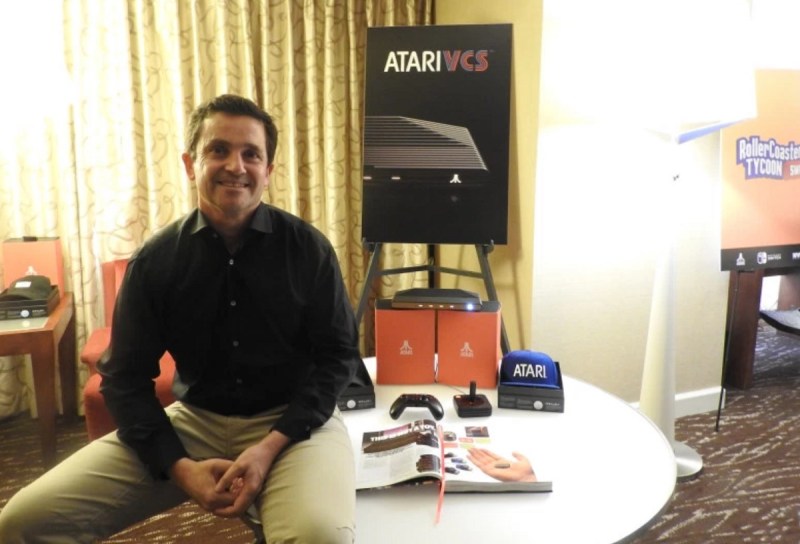
Above: Atari CEO Fred Chesnais shows off the Atari VCS game console.
Fred Chesnais: So, Feargal [Mac Conuladh, former general manager of the Ataribox project], is no longer with us.
GamesBeat: Do you have someone else taking over?
Chesnais: Michael Arzt (head of Atari Connected Devices). He’s been with us for more than a year. He’s been pushing the project and coordinating with Feargal. Feargal left the day — we announced we were going live on December 14, and he left on December 13. Nothing else to say.
GamesBeat: And now you’re back on track?
Chesnais: Yeah. The question is, why did we abort? We realized we weren’t ready. We had lots of issues to fix, things we could do better. We chose to postpone it. We’re still working. The great thing about pausing is it gave us a window to do even more, to do another top to bottom audit. We can make sure all the boxes are checked. In a complex project sometimes you have to stop.
GamesBeat: Do you have a revised schedule now?
Chesnais: We’re going to make the announcement soon. We’ve been able to review everything, go through the checklist, watch for red flags. We’re talking with the content guys, with the engineers, everything.

Above: Atari VCS is the name of the new Atari console.
GamesBeat: Are you keeping other details the same, like the target price?
Chesnais: Yes, we’ve said $249, with the controllers. You can see the joysticks, the new classic joystick. Business-wise, we’ll have the fans, the nostalgia. It’s a nice product. It fulfills a lot of functions. It addresses a lot of needs in the market. You’re only as good as your product. The strategy is still the same, to go with a crowdfunding campaign and test out the interest. We don’t just want to dream. We want to deal with reality. If the reality is 5,000 units, we’ll deal with that. If it’s 50,000, 500,000, we’ll deal with that. We just want to do it right.
GamesBeat: Is it still running Linux on an AMD processor?
Chesnais: Right.
GamesBeat: So it can run more modern games?
Chesnais: It’s retro-inspired, but it’s very much a modern device. The analogy I always use is it’s a Mini Cooper. It looks like it came from the ‘70s, but it’s a modern car. This does everything a modern device should do.
GamesBeat: Are you going to make additional games available to run on it, or do you have a bunch of games that already run on it?
Chesnais: Well, we already have games, yes, but it’s also a streaming box. As long as the specs are fine, you can find many games on the internet. But also, we’re going to partner with developers once they can get their hands on the device. We have a vault of more than 200 games, and we’re going to give that to the community. At the same time, we want to keep some of these games for the types of experiences that are also available on PC. We’ll find a balance.
We’re currently looking for indie devs. Part of the plan is that we want to have a store. This is not a hit and run project for us. It’s really a long-term project.
GamesBeat: Is the wood version the most popular one so far?
Chesnais: The wood one is the one we’re leading with, because that’s the one that’s most retro. The really hardcore fans are going to be the first buyers, and they respond to that the most. That’s the special one. There are other iterations, other design concepts we can and will bring into play later. But that’s the one we’re leading with. It brings past and present together the best.
GamesBeat: After pre-sales start, do you just set a date for shipping?
Chesnais: There’s nothing that isn’t feasible. It’s really just a question of manpower. We have a plan after that. The most difficult tasks have been the drives, the manufacturing, the chip, the design. The design is critical. I’m not saying we’re on a roll, because that would mean it’s easy, but there’s a plan. There’s a lot of work to do on software and firmware. A lot of moving parts still have to come together.
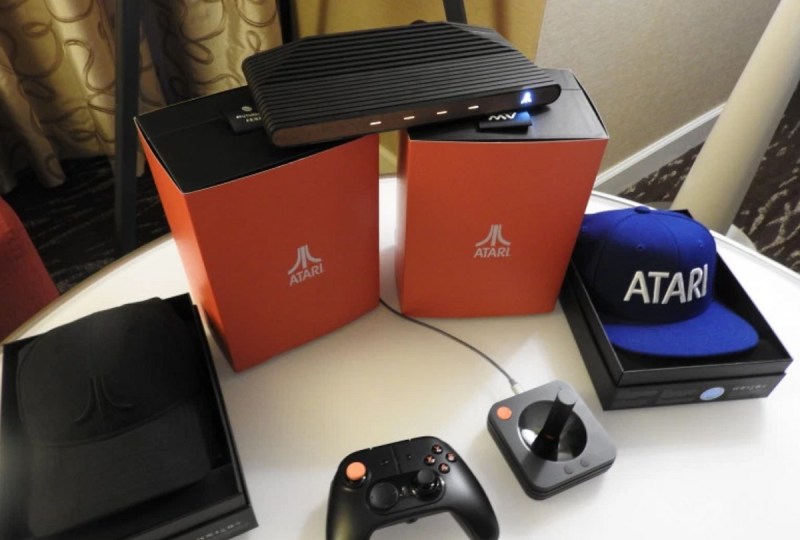
Above: The Atari VCS will run Linux on AMD-based hardware.
GamesBeat: Have you assembled a team to do all this?
Chesnais: Yes, the organization is in place. It’s also good to be able to take advantage of three extra months. I always say internally that it’s been 40 years, so we can wait four more months to get it right. We’re very humble. We’ll see how big the market is. We’re not making any bets. That’s why we’re doing crowdfunding. We’re trying to do the right thing. We’re trying to be cautious. In December we proved that we’re willing to abort the countdown. These things take time.
GamesBeat: What sort of feeling have you absorbed from the fans so far?
Chesnais: I’m glad that there’s a debate about good, bad, could be great, could be junk, because that means people care. Most of the responses to this week’s announcement have been very positive. Our message for this week is, “It’s still here. We didn’t go away. It’s still moving forward. Here’s the real name. Here’s the engineering models and design models to show you.” It’s marking a milestone to show that this is still happening.
How people respond to it, how people respond to the real name, which certainly evokes some nostalgia — it’s certainly a descriptive name. All that stuff has been largely positive. I welcome the engagement with the community. That’s a lot of what Atari is about.
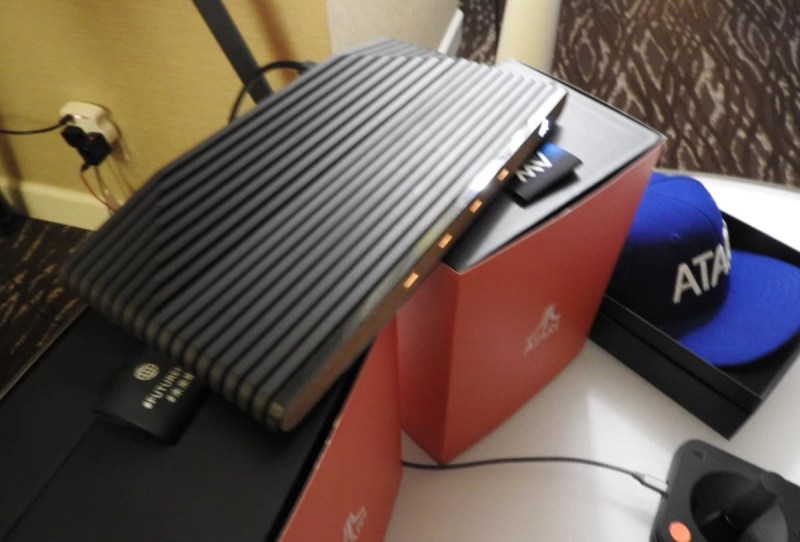
Above: The Ataribox will now be known as the Atari VCS.
We don’t pretend that we have the truth in our hands. We change things. We listen to our community. It’s a big difference compared to 40, 30, 20 years ago. You’d put a game out there and say, “Here, it is what it is.” Now you share a lot. You share design and functionalities. I don’t want to say it’s cooperative, but you try to be more proactive in showing and sharing what your product will be. You can make fewer mistakes that way. But there will always have a debate.
You’ll have people who love you and people who hate you, and they’re both usually the most vocal. Our responsibility is to go through all the comments and say, “Okay, this is legit, and this isn’t.” And the ones that are legit, let’s address those. Some things we’re not prepared to talk about yet, and people resent that, but we’re no different from other any product. You always keep a bit up your sleeve.
GamesBeat: Some of these games, are they meant to be entirely separate, or in some way coordinated with the hardware?
Chesnais: Things like Tempest 4000, we’ll have a version on the box. There are other games coming. I’m sure we’ll have versions of Rollercoaster Tycoon and other things on there that people have seen already. Then there are things coming — we’re courting developers to develop new games, both with their IP and our IP. But first and foremost it’s a VCS, a Video Computer System. It’s bringing the best of your PC experience to your TV. It has some limitations, because it’s not a high-end PC. But it’s also something you’re proud to show off. I think it will bring a lot of satisfaction to users.
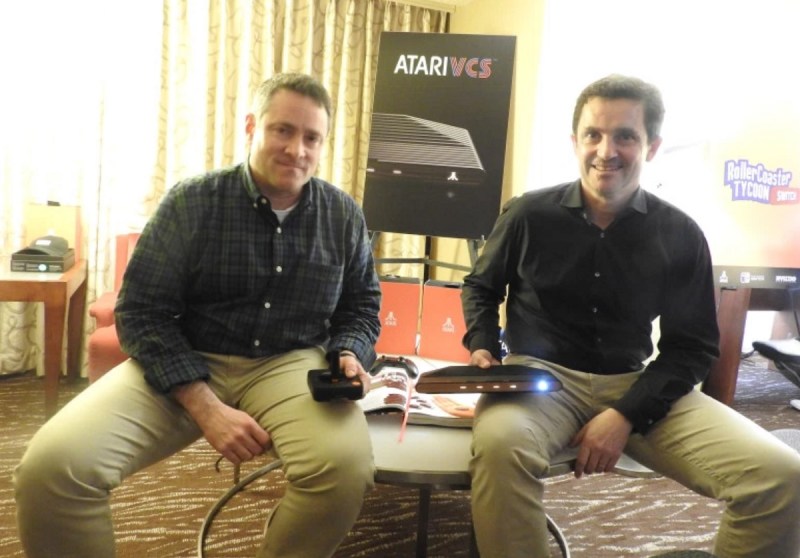
Above: Fred Chesnais (left) and Michael Arzt of Atari with the Atari VCS.
GamesBeat: I saw the little Ready Player One thing. Are you guys excited for that?
Chesnais: Yeah, it’s going to bring some more attention. We were very excited when Blade Runner came along, too. That was crazy, that it was such a centerpiece of their marketing. It shows the power of the brand. It’s a brand of a generation. It stands for a revolution in tech and entertainment.
GamesBeat: Are you guys in the movie, then?
Chesnais: Yes, we are.
